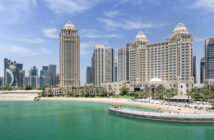By Noora Dabbagh
From sparkling beaches to fascinating locales to fun fiestas teeming with energy and color to spicy gustatory delights; Mexico is truly the jewel of Latin America.
Mexico is one of the seven cradles of civilization. With a unique millenary culture that dates back to 1200 BC, Mexico is home to 34 UNESCO World Heritage sites, 27 of which are cultural. Mexico has the 14th largest economy in the world and is also most populated Spanish-speaking state. Mexico’s cuisine is a true culinary delight, as was the first of its kind to be named by UNESCO as “Intangible Cultural Heritage”. Mexico has a strong highly diversified economy and is the 13th largest exporter worldwide and gains recognition for its manufacturing and high-technology industries.

Bilateral Economic and Trade Relations
With a formidable relationship that dates back to the early 1980s, Saudi Arabia is a strategic partner for Mexico because of its economic, political and cultural significance. Both countries are part of the G20, and Saudi Arabia is Mexico’s second biggest trading partner in the region and its 41st partner globally. Mexico manufactures iron and steel. These, along with electronics and auto parts, are the country’s main exports to Saudi Arabia. Moreover, Mexican companies such as KidZania and TAMSA have established a presence in Saudi Arabia and are contributing to the Kingdom´s economic diversification plans.
The Embassy participates in economic and commercial events such as missions, forums, and meetings with businessmen to promote trade, attract investment and increase the presence of Mexico in the region. Mexico is going through a deep transformation process in keysectors such as energy, telecommunications, labor, and education. This process is making it more competitive, accountable and attractive to foreign investors.
Cultural Promotion
Mexico has one of the greatest cultural richness and biodiversity of the planet. Moreover, indigenous heritage combines with the colonial period and the modern era in such ways that, today, there are more than 65 spoken languages in Mexico. The exceptional cultural diversity of the country goes hand in hand with the privileged biodiversity of its territory that makes Mexico one of the 17 megadiverse countries.

Other features of Mexico´s culture include colorful traditions like Día de los Muertos (Day of the Dead), the Mariachi music and vibrant artistic expressions –portrayed by world-renowned artists like Frida Kahlo, Diego Rivera, and Leonora Carrington; distinguished writers like Octavio Paz, Juan Rulfo, and Carlos Fuentes, and prominent filmmakers like Guillermo del Toro, Alfonso Cuarón, and Alejandro González Iñárritu.
Consular Services
Part of the regular activities of the Embassy is done at the Consular Section, which provides services and coordinates the relations with the community, not only in Saudi Arabia but in Bahrain, Oman, and Yemen as well.
Consular services include, first, protecting and documenting Mexican nationals by issuing passports, birth certificates, voter cards, and legal orientation, amongst others. Second, issuing visas for foreigners that want to visit Mexico, taking into account that people with either nationality or legal residency or valid visa from the United States, Canada, Japan, the United Kingdom or the Schengen domain do not require a Mexican visa to visit Mexico.
Gastronomic Delights
The Embassy of Mexico and the InterContinental Hotel in Riyadh will hold the “Gastronomic Festival 2018” on September 17-22, 2018. Chef Eduardo Pérez will prepare an assorted menu that will challenge the sens- es and delight the palates of Riyadh. During the festival, people will be able to participate in cooking classes, in which Chef Pérez will share some of his best recipes. The words “chocolate” and “avocado” come from xocolātl and āhuacatl of the Nahuatl language, used in Mexico since the 14th Century by the Aztec Empire. These words have been important parts of the language of gastronomy, an important culinary and linguistic heritage from Mexico to the world. A delicious reflection of the vast culinary, social and historical processes that span throughout the country and represent a fundamental factor in community development.

Where To Go
- Cancun is one of the favorite summer destinations, an idyllic place with fine white sand and blue-green waters.
- Recognized by the UNESCO as a World Heritage Site, Oaxaca is rich in history and culture. Watch the jacarandas bloom in March, visit the fluorescent lagoons, archaeological sites, and colonial treasures.
- Mexico City has it all! Famous for its overlapping plurality, folklore, and modernity, the city has the largest number of museums in the world and offers an incredible diversity in restaurants, nightlife, and entertainment.
- A unique mixture of desert landscapes, beaches, and mountainous zones located at the south end of the Baja California Peninsula, Los Cabos is a real paradise between two seas.
- Emerging from a valley and surrounded by mountains, San Cristobal de las Casas is a quaint town with narrow, cobble- stone streets and bright color houses.

What To Do
- Enjoy the gastronomy of Mexico. In Puebla, be sure to try “chiles en nogada”, a stuffed chili with a walnut sauce and pomegranate, and chicken with “mole poblano”, a recipe of more than 20 ingredients including chilies and chocolate. Try the papadzules, a corn tortilla dipped in creamy pumpkin seed sauce to get a taste of Yucatan cuisine. Experience “cabrito” (goat meat), a regional specialty in Monterrey. And while under the shade of a palm tree in the beach, don’t forget to order the “ceviche mixto,” diced fish, shrimp, and octopus in lime juice, tomatoes, and onions.
- Visit the pyramids of Teotihuacan in a hot air balloon ride.
- Stop by the pyramids of Chichen Itza, considered one of the “New Seven Wonders of the World”.
- Walk the ruins of jungle-shrouded Yaxchilan, an ancient Maya city in the bank of the Usumacinta River. The site is well- known for its well-preserved sculptured stone lintels.
- Feast your eyes on the beautiful costumes of dancers from the seven regions of Oaxaca. Attend the Guelaguetza festival and watch the traditional dances, incuding the Pineapple dance and Feather dance.




